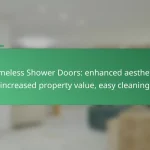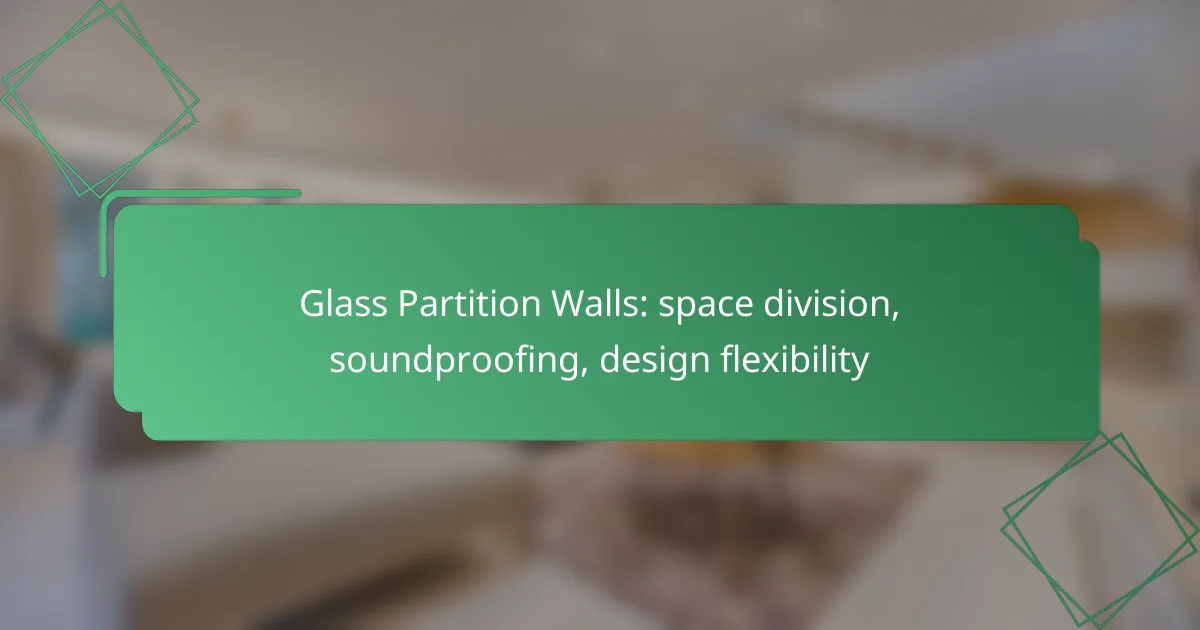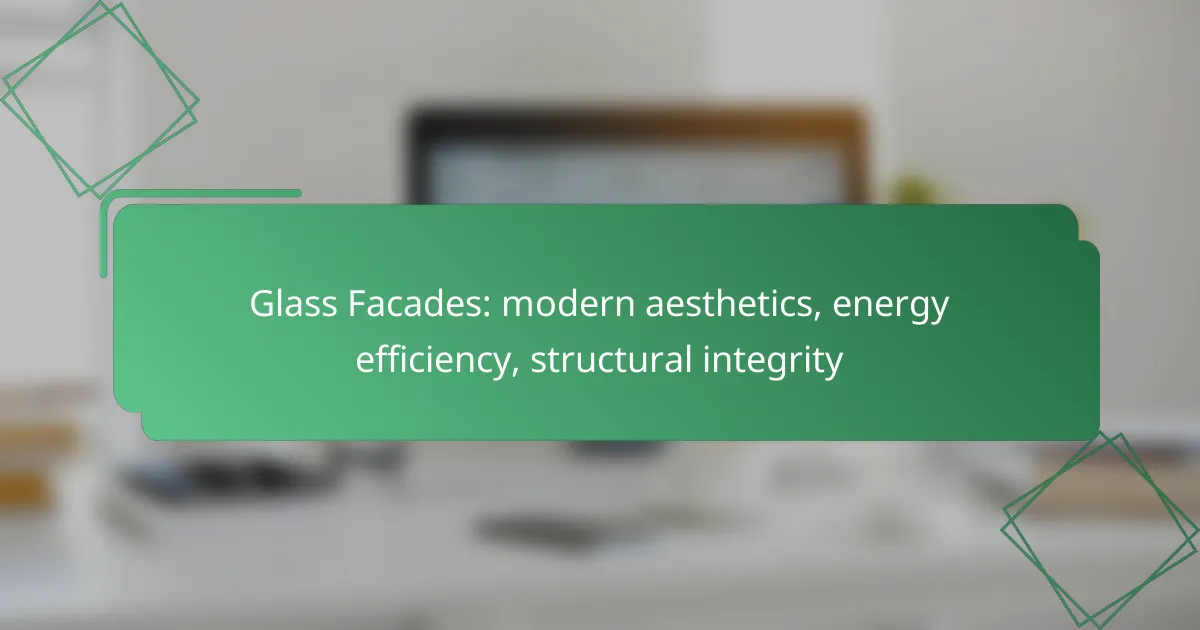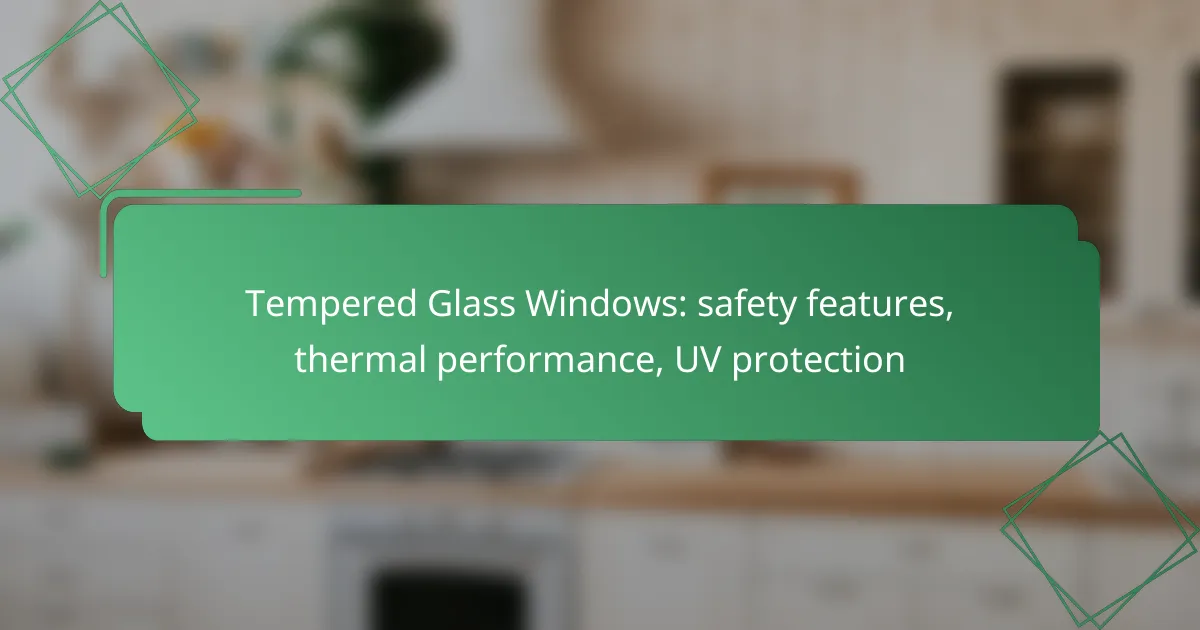Glass partition walls offer an innovative solution for space division in offices, providing distinct areas while preserving an open atmosphere. Their design flexibility allows for adaptable configurations that meet evolving needs, while effective soundproofing techniques enhance privacy and minimize noise transmission. This combination not only promotes collaboration but also contributes to a workspace that reflects the company’s culture and values.

How do glass partition walls enhance space division in Canadian offices?
Glass partition walls significantly improve space division in Canadian offices by creating distinct areas while maintaining an open feel. They allow for flexible configurations that can adapt to changing needs without the permanence of traditional walls.
Flexible layouts
Glass partition walls offer the versatility to create various layouts, accommodating different work styles and team sizes. This flexibility enables businesses to easily reconfigure spaces for collaboration, privacy, or individual work as needed.
For example, a company can use movable glass partitions to quickly transform an open area into smaller meeting rooms or brainstorming zones, enhancing productivity and responsiveness to project demands.
Maximized natural light
One of the key benefits of glass partition walls is their ability to maximize natural light throughout the office. Unlike solid walls, glass allows sunlight to flow freely, reducing the need for artificial lighting and creating a more inviting atmosphere.
In Canadian offices, where winters can be long and dark, this feature not only improves employee morale but can also lead to energy savings, as spaces remain well-lit during daylight hours.
Efficient use of space
Glass partition walls enable a more efficient use of space by minimizing the physical footprint of divisions between areas. This can lead to better utilization of square footage, especially in smaller offices where every square meter counts.
By implementing glass partitions, businesses can create multifunctional areas that serve multiple purposes, such as combining meeting spaces with lounge areas, thus optimizing overall office functionality.
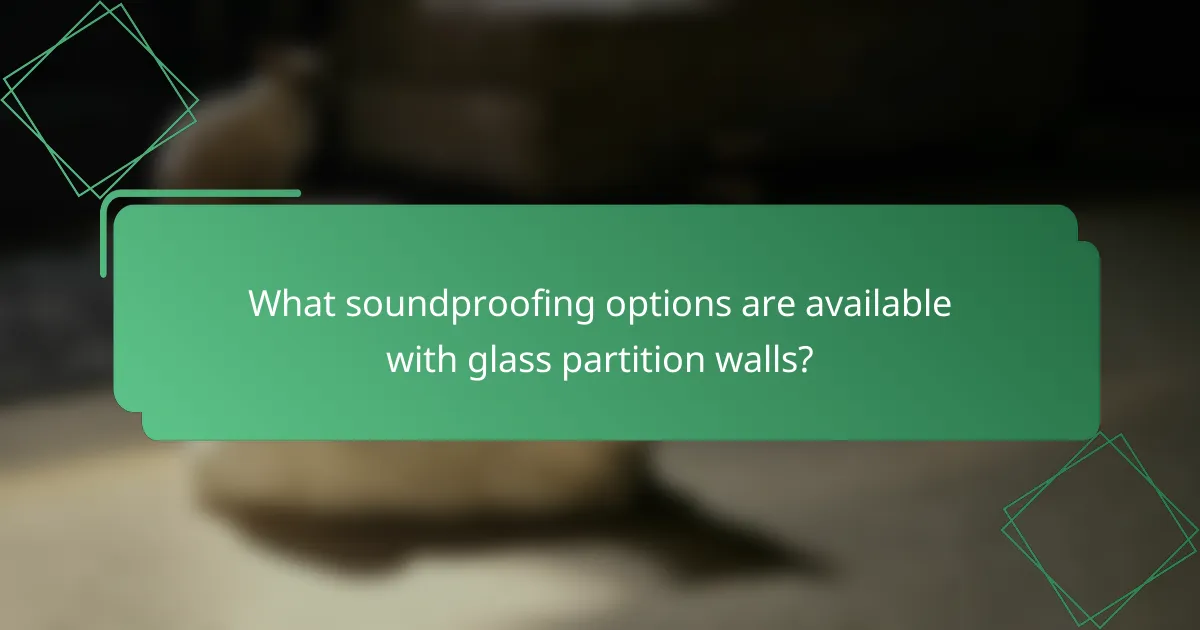
What soundproofing options are available with glass partition walls?
Glass partition walls can be effectively soundproofed using various techniques and materials. These options enhance privacy and reduce noise transmission, making them ideal for office spaces and other environments where sound control is essential.
Acoustic glass solutions
Acoustic glass is specifically designed to reduce sound transmission between spaces. It typically features a thicker profile or a laminated structure that includes sound-dampening interlayers, which can significantly lower noise levels. When selecting acoustic glass, consider the Sound Transmission Class (STC) rating, which indicates its effectiveness; higher ratings generally mean better soundproofing.
For optimal performance, use acoustic glass in combination with other soundproofing methods, such as sealing gaps and using sound-absorbing materials in adjacent areas. This layered approach can enhance overall sound isolation.
Soundproofing materials
In addition to acoustic glass, various soundproofing materials can be incorporated into glass partition systems. These may include sound-absorbing panels, acoustic seals, and resilient channels that help minimize sound transmission. Materials like mineral wool or foam can be placed in the wall cavities to further reduce noise levels.
When planning your installation, assess the specific soundproofing needs of your space. A combination of glass and soundproofing materials can achieve a balanced aesthetic while effectively controlling noise. Be sure to consult with professionals to ensure compliance with local building codes and standards for soundproofing.
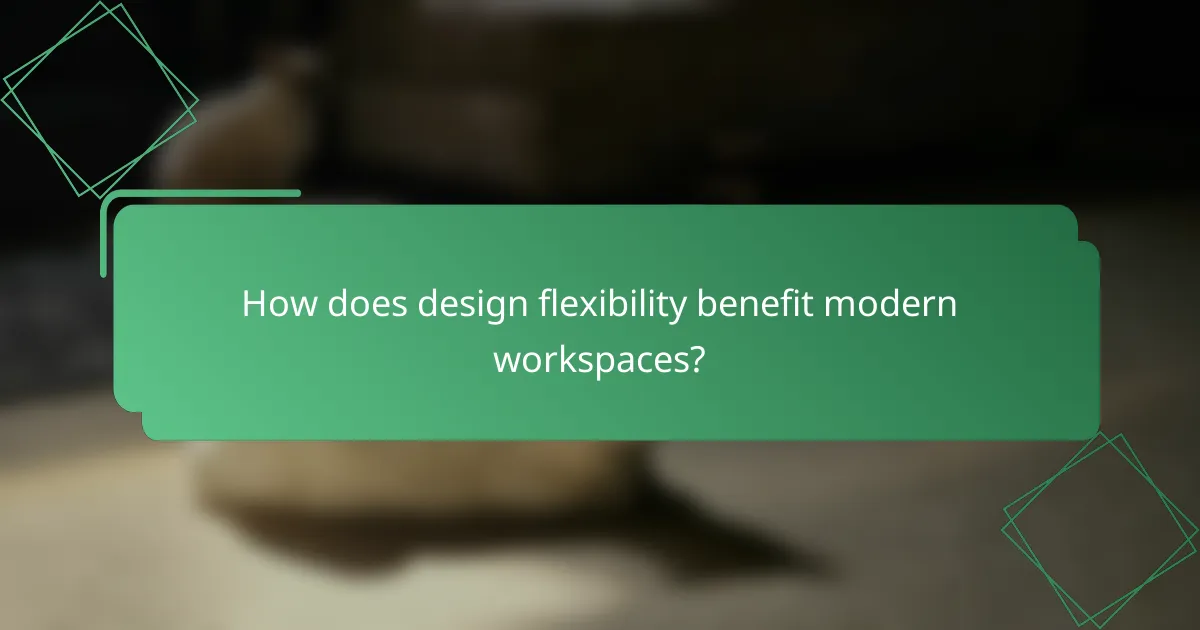
How does design flexibility benefit modern workspaces?
Design flexibility in modern workspaces allows for adaptable environments that can evolve with changing needs. This flexibility enhances functionality, promotes collaboration, and can improve employee satisfaction by creating spaces that reflect the company’s culture and values.
Customizable aesthetics
Customizable aesthetics enable businesses to tailor their workspace to reflect their brand identity. Glass partition walls can be designed with various finishes, colors, and textures, allowing for a cohesive look that aligns with the company’s image. For example, frosted glass can provide privacy while still allowing light to flow, creating an inviting atmosphere.
When considering aesthetics, think about the overall theme of your workspace. Incorporating elements like graphics or branding on the glass can further enhance the visual appeal and create a unique environment that resonates with employees and clients alike.
Integration with existing decor
Integrating glass partition walls with existing decor can create a seamless transition between different areas of the workspace. These partitions can complement various design styles, from modern minimalist to more traditional settings, ensuring that the overall aesthetic remains harmonious. For instance, using wood frames with glass can add warmth while maintaining an open feel.
To achieve effective integration, assess the current decor and color palette of your workspace. Choose glass partitions that enhance rather than clash with existing elements, and consider using adjustable lighting to highlight the beauty of the glass while maintaining a cohesive look throughout the office.
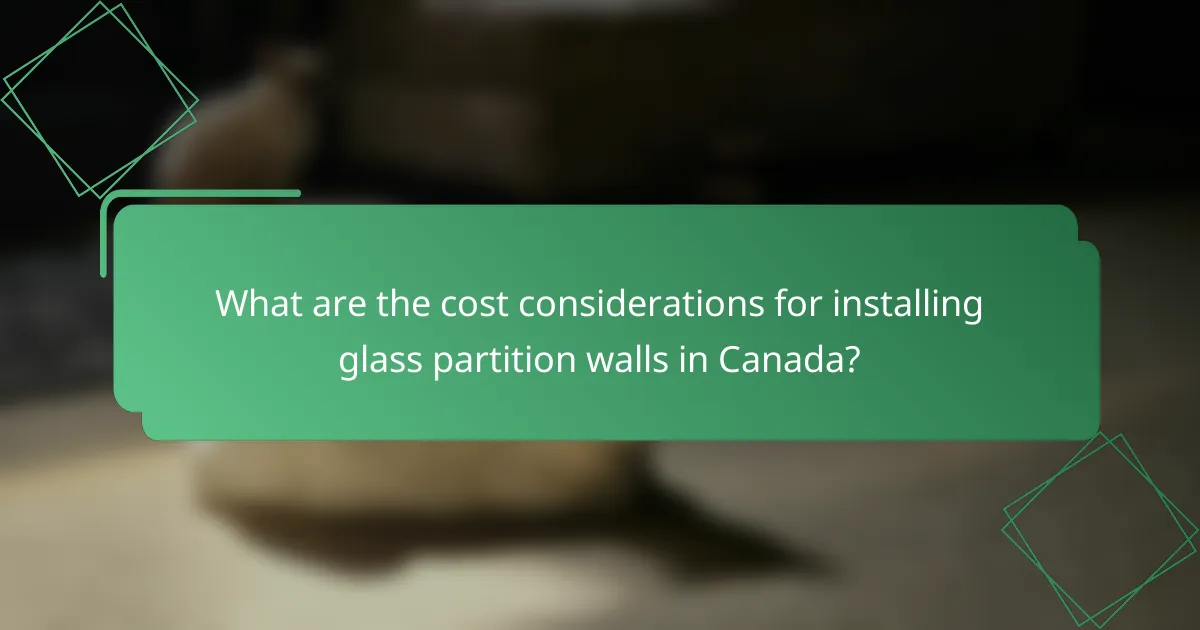
What are the cost considerations for installing glass partition walls in Canada?
When installing glass partition walls in Canada, key cost considerations include material costs and installation expenses. Understanding these factors can help you budget effectively and make informed decisions for your space division needs.
Material costs
The material costs for glass partition walls can vary significantly based on the type of glass chosen. Standard tempered glass may range from CAD 50 to CAD 100 per square foot, while specialty options like laminated or soundproof glass can cost upwards of CAD 150 per square foot.
Additionally, framing materials, such as aluminum or steel, will add to the overall expense. Expect to pay around CAD 20 to CAD 40 per linear foot for quality framing, depending on the finish and design complexity.
Installation expenses
Installation expenses for glass partition walls typically range from CAD 30 to CAD 60 per square foot. This can fluctuate based on the complexity of the installation and the experience of the contractors involved.
It’s advisable to obtain multiple quotes from licensed professionals to ensure competitive pricing. Be mindful of potential additional costs for electrical work or modifications to existing structures, which can further impact your overall budget.
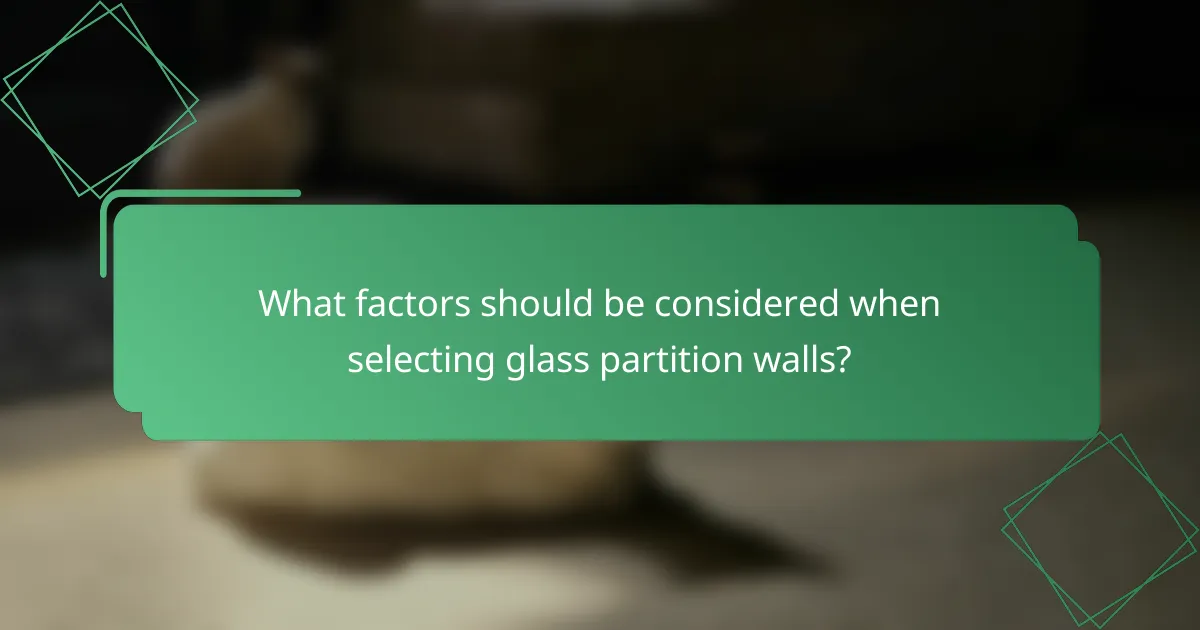
What factors should be considered when selecting glass partition walls?
When selecting glass partition walls, consider factors such as building regulations, the intended purpose of the space, soundproofing requirements, and design flexibility. These elements will significantly influence the functionality and aesthetic of the installation.
Building regulations
Building regulations vary by location and can dictate the types of materials and construction methods used for glass partition walls. It’s essential to check local codes to ensure compliance with safety standards, fire ratings, and structural integrity requirements.
For example, in many jurisdictions, glass partitions must meet specific fire resistance ratings, which can affect the choice of glass type and framing materials. Consulting with a local building authority or a professional contractor can help navigate these regulations effectively.
Purpose of use
The intended use of the space plays a critical role in selecting glass partition walls. For office environments, consider whether the partitions need to provide privacy, sound insulation, or simply delineate space. Each purpose may require different types of glass and framing solutions.
For instance, if soundproofing is a priority, opt for laminated or double-glazed glass, which can significantly reduce noise transmission. Conversely, if the goal is to create an open, airy feel, clear glass panels may be more appropriate. Assessing the specific needs of the space will guide the selection process effectively.
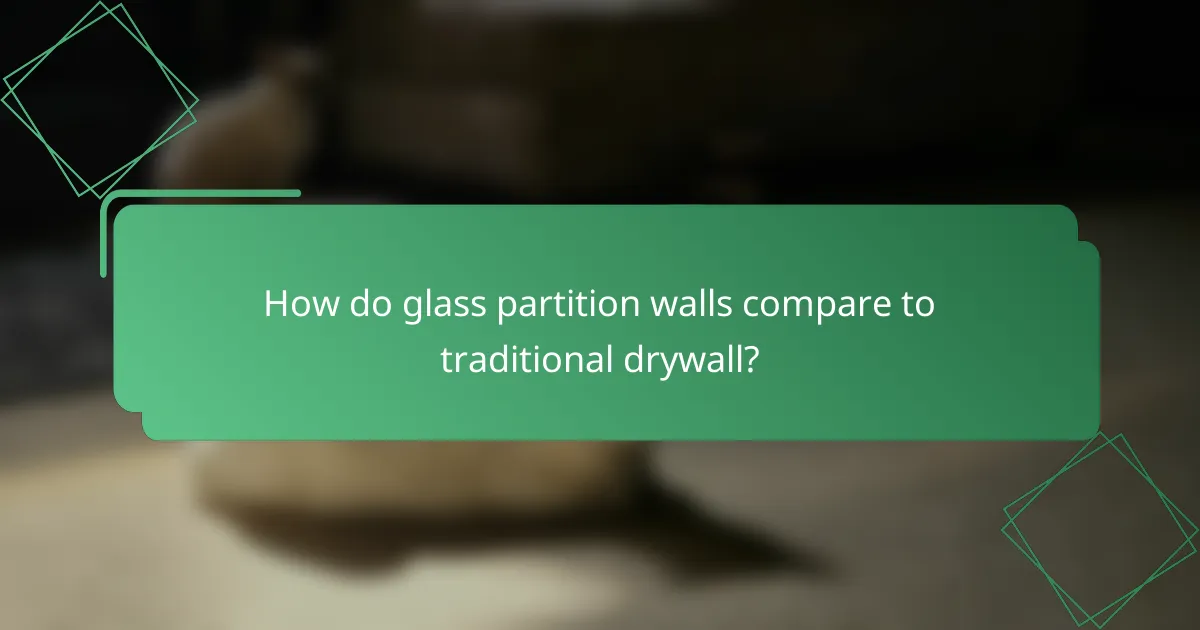
How do glass partition walls compare to traditional drywall?
Glass partition walls offer a modern alternative to traditional drywall by providing enhanced aesthetics, better soundproofing options, and greater design flexibility. Unlike drywall, which can create a closed-off environment, glass partitions allow for natural light and open sightlines while still dividing spaces effectively.
Installation time
Glass partition walls typically require less installation time compared to traditional drywall. While drywall installation can take several days due to framing, taping, and finishing, glass partitions can often be installed in a matter of hours or a single day, depending on the complexity of the design.
For example, a simple glass partition might be set up within a few hours, while more intricate designs with multiple panels could take a full day. This rapid installation minimizes disruption in office environments, making it an appealing choice for businesses looking to upgrade their spaces quickly.
Maintenance requirements
Maintenance for glass partition walls is generally straightforward and less intensive than for drywall. Glass surfaces can be easily cleaned with standard glass cleaners, while drywall may require periodic painting or repairs due to dents and scratches.
However, it’s essential to check the seals and frames of glass partitions regularly to ensure they remain airtight and soundproof. In high-traffic areas, consider using tempered or laminated glass to enhance durability and reduce the risk of damage.




